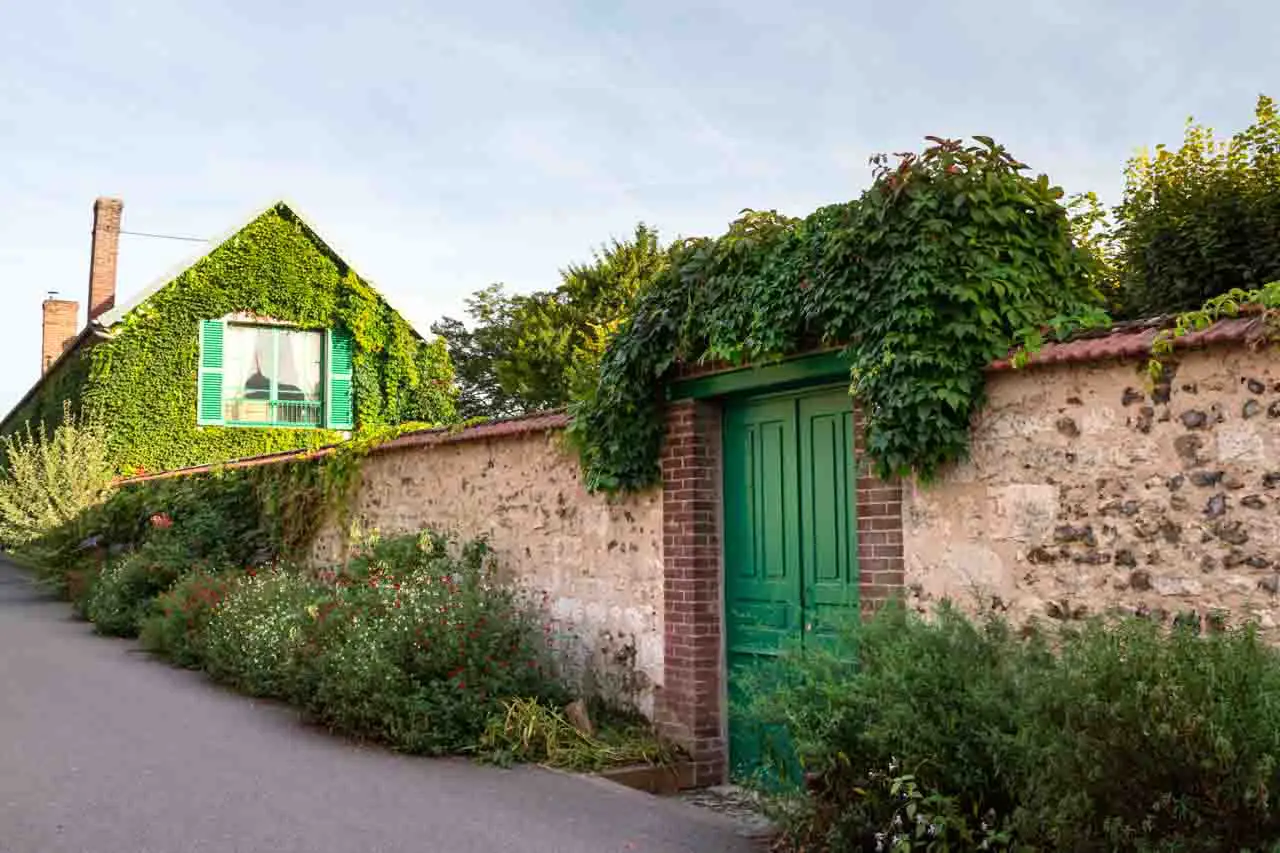To saunter through Monet’s garden and home in Giverny, is to immerse yourself in an Impressionist painting. Claude Monet designed and created this stunning landscape with an artist’s eye for colour and composition. He conceived a place so inspiringly beautiful that he was compelled to paint it again and again. You know the paintings, now let’s visit Monet’s home and garden in Giverny.
Claude Monet’s home and garden
Monet resided in Giverny for over forty years. He favoured the quiet, rural village lifestyle and the surrounding landscapes for painting. He moved there in 1883, renting the farmhouse at first with his spouse Alice and their blended family of eight kids.
Over time Monet extended the home and incorporated the once standalone barn into the home for use as a studio. The artist chose the colour scheme of pink stucco walls and emerald shutters. He added the front gallery, rose-covered pergola and Virginia creeper façade to blend the home and garden visually. Today the home still exhibits Monet’s personal collection of Japanese woodblocks along with other art and furnishings belonging to the artist.
The Clos Normand
Monet’s garden in Giverny was one of his own design and creation. Originally, the gently sloping yard had cypress alleys and an orchard of fruit trees surrounded by stone walls. Monet planted flowers by such as poppies, sunflowers, nasturtiums, daffodils and primroses. He grouped colours and mixed plants in a way that would create a cycle of continuous blooms throughout the season.
In the late 1880s Monet was able to purchase the property and began to make more substantial changes. He hired two full-time gardeners, built a greenhouse and rented a nearby plot to relocated the fruit and vegetables. He traded seeds and cuttings, and expanded his collection of flower species. This was the beginning of the Clos Normand – the enclosed flower garden you see today directly adjacent to the house.
The Water Garden
In 1893, Monet purchased the plot of land across the road (and then also a railroad), to create his Japanese-inspired water garden. There he built the arched bridges, grew towering bamboo, weeping willows and introduced water lilies to the pond that he filled by redirecting water from the River Epte.






Giverny day trip from Paris
Giverny is a commune (aka township) in the Normandy region of France, that lies about 75km northwest of Paris. It is located on the Right Bank of the Seine, where it is met by its tributary, the Epte River. If you are staying in Paris, Giverny is a relatively easy half or full day trip out of the city.
Giverny overnight from Paris
Though it is a comfortable day trip from Paris, I can’t tell you how glad I am that we decided to spend the night in Giverny. Like Mont Saint Michel, you get more of an idea of the true atmosphere of the commune once the day trippers have departed and the village quietens down.
Though Giverny does not have the range of accommodation options that nearby Vernon has, there are plenty of lovely B&Bs. I also highly recommend making sure you book a table for dinner at your preferred restaurant, with limited dining options compared to larger towns, walk-in tables can be hard to come by.
Getting to Giverny, France
Giverny by car
If you have access to a car and are brave enough to drive, take the ring road out of Paris and follow the A-13 toward Rouen. Exit at Sortie 14 toward Vernon and follow the Centre Ville signs followed by the signs to Giverny. When you come to the roundabout (there is only one) you will see a large, free parking lot. The ancient village has small, narrow, one-way roads so this is definitely the best place to leave your car and set out on foot.
Giverny by tour
There are various tour companies that offer small to large bus options from Paris. For smaller minivan options, budget around €90-115 per person. Larger buses are generally less expensive at around €60. The advantage of a tour is direct, often door-to-door travel from Paris to Monet’s residence and you don’t have to drive yourself.
Giverny by train
Take the Rouen-bound train from Paris Gare Saint Lazare to Gare de Vernon (Vernon is the larger, neighbouring town to Giverny). From Vernon you will need to transfer to Giverny. There is a shuttle bus that departs 15-minutes following each trains arrival and costs €5 per person each way, paid to the driver. You can also rent a bike in Vernon and cycle the 5km/3mi paved route to Giverny that follows an old railroad.
Monet’s home and garden tickets
You can purchase tickets to Monet’s Home and Garden in advance through the official website or Ticketmaster. Tickets can be purchased in person, on the day, however during the busy summer season it is advisable to purchase your ticket in advance. Admission purchased direct on the official Fondation Monet website will cost €12 per adult and €11 in person. Resellers such as Ticketmaster charge €13 per ticket.
More things to do in Giverny
Musée of Impressionnismes
Giverny also has a Museum of Impressionism (Musée of Impressionnismes) which hosts temporary art exhibits. They offer a combined ticket with Monet’s garden in Giverny for €18 per adult which can only be purchased at the Museum ticket office.
Visit Monet’s grave
Less than 1km/0.7mi from Monet’s home you will find his grave at Eglise Sainte Radegonde de Giverny. The church itself dates back to the late Medieval period. You will find Monet’s final resting place in the church graveyard along with Gerald and Florence van der Kemp, largely responsible for the restoration of Monet’s home and garden. There is also a memorial to the RAF crew whose plane crashed nearby during WWII.
Take a walk
Giverny is a gorgeous little town to explore on foot. There is a cultural trail around the village with markers in French and English to inform you of significant sites. There is also the aforementioned cycling trial between Giverny and Vernon that is also good for walking.
Auvers-Sur-Oise & Giverny combo
Why settle for one cute commune and extraordinary artist, when you can have two (or more)? Did you know that Vincent Van Gogh spent his final months in a town only an hour’s drive from Giverny? Van Gogh was one of several artists that lived and painted in the commune of Auvers-sur-Oise, including Paul Cézanne, Charles-François Daubigny and Camille Pissarro.
If you are driving, I highly recommend combining your visit to Giverny with some time in Auvers-sur-Oise, which is located only about 36km/22mi from Paris. There are also one or two bus tours that combine the two destinations into a day trip.
When you arrive, drop into the local tourist office to get an audio guide that will take you around the important art-related sites around town. Strap on your comfy walking shoes and follow the cultural trail that includes locations painted by Van Gogh, his grave, and the home of Doctor Gachet. You can also tour Vincent’s room and dine at Maison de Van Gogh in the Ravoux Inn, where the artist lived and died. Check opening dates and hours, and/or make a reservation here.




Tips for visiting Monet’s home and garden
Back to Monet… here are a few tips for getting the best out of your visit to Monet’s garden in Giverny:
- Monet’s garden is most colourful from May to July, however blooms continue well into early Autumn. We visited in mid-September and there was still an abundance of blooms in Clos Normand, but with only a few waterlilies remaining in the Water Garden.
- The busiest months are May through June, and Sunday mornings are the most crowded during cruise ship season.
- If you are travelling on your own schedule (not on a tour), time your visit for first thing in the morning when it opens or after 4pm to avoid the biggest crowds.
- Save time by purchasing tickets in advance if you are going to be visiting during the busiest months or during the middle of the day.
- Due to the relatively small space and large number of visitors, there is no picnicking, wedding photo shoots or painting/sketching allowed on the property.
- Only small backpacks or bags are permitted. The maximum size allowed is 55cm x 35cm x 20cm (22in x 14in x 8in) and there is a security check upon entry.
- Fondation Monet publishes their list of approved guides including the languages they speak, here, for those wanting a guided tour of the home and garden.
- The Fondation also publishes a calendar of flowers so you can see what will be blooming during your visit.
- If you arrive first thing in the morning, go straight to the Japanese gardens and get your photos of the Japanese bridges before the crowds show up and then work your way back to the house. It is much more difficult to get these shots once more people arrive (unless you don’t mind strangers in your photos).
Monet in Paris
If you’re looking to brush up on Impressionism art before you visit Monet’s garden in Giverny, here are the best Museums for artworks by Monet in Paris:
Musée de l’Orangerie features eight monumental Water Lily paintings in two custom-designed, elliptical rooms created to showcase the art. Also, don’t miss the Museum’s small but excellent collection of Modern art by painters such as Matisse, Utrillo, Renoir and Picasso.
Musée d’Orsay also possesses some significant Monet paintings among its incredible collection and is a highlight of any visit to Paris. Monet’s Women in the Garden (1866), Coquelicots (1873), Nymphéas Bleus (1919), The Water Lily Pond (1899) and more are held there.
Musée Marmottan Monet houses the world’s largest collection of Monet’s works. The Museum’s collection includes both art painted by Monet and collected by the artist. Much of the collection was bequeathed by Claude’s youngest son and last remaining heir. The collection also contains works by Monet and artists such as Gauguin, Moriso, Sisley and Manet, endowed by other benefactors.
I hope you love your visit to Monet’s home and garden in Giverny, France as much as I did. Even the most casual art enthusiasts will find it a wonderful and worthwhile day trip from Paris–even better if you are lucky enough to spend a night in the picturesque town.
Peace, love & inspiring travel,
Madam ZoZo




